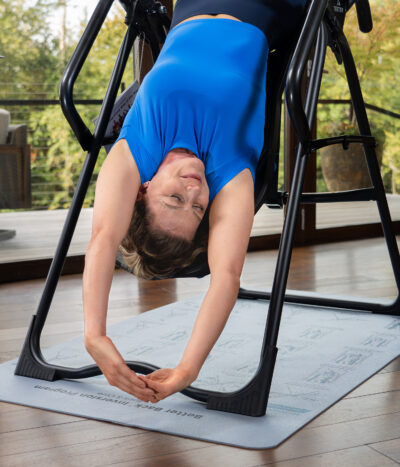When the days start getting longer and the weather warms up, your body definitely feels the change. Maybe you’re just feeling a renewed motivation to get outside and move around. You might find your joints feeling a bit looser, or perhaps you’re experiencing some back aches that weren’t there a few weeks ago due to your increase in activity. Seasonal changes can have a pretty big impact on how you feel.
Understanding the science behind the effect of weather on your back and joints and adopting a few smart strategies – from simple stretching to using an inversion table – can help you stay comfortable and active year-round.
How Can Warm Weather Cause Back Pain Flare Ups?
Here’s what happens in your body when the temperatures rise:
- Barometric pressure changes can play tricks on your joints. As the weather changes, so does air pressure. When barometric pressure drops (often just before a summer storm), your joints may expand a bit and put pressure on surrounding nerves. This can lead to aches and stiffness in your spine.
- Heat and humidity might ramp up inflammation. While warmth can help relax your muscles, extreme heat and high humidity can sometimes make things tougher for some individuals. Your tissues may swell slightly, aggravating old injuries or sparking muscle strains.
- Dehydration = Disc discomfort. Your spinal discs are largely made up of water. In the summer, you’re likely to sweat more and might not even realize you’re getting dehydrated. A lack of hydration can lead to reduced cushioning in your spine, potentially resulting in more pain.
- You’re more active, which is great, but it can backfire. Spring and summer bring a burst of activity. That’s awesome for your back if you ease into it. But doing too much too soon, like gardening, biking, or cleaning out the garage, can leave your back protesting the next day.
How Seasonal Changes Impact Your Joints
Shifting from winter hibernation to summer activity is quite a transition! Here’s a look at how these seasonal changes can affect your body:
- Winter: The cold temperatures can restrict blood flow, leading to stiffer muscles and joints. We also tend to be less active during this time, which can weaken our back and core muscles.
- Spring: With the weather changing, we might experience unexpected pain flare-ups due to the fluctuations in temperature and barometric pressure. Plus, many of us jump right from being inactive to a much higher level of activity.
- Summer: Once the weather settles down, most people start feeling better. The warmer temperatures can help loosen those stiff muscles, as long as you remember to stay hydrated and avoid overheating!
Warm Weather Back Pain Solutions
As spring rolls in, it’s the perfect opportunity to enjoy the gentle warmth, longer days, and that burst of motivation to get outside and keep moving. Here are some friendly tips to ease into the season while staying comfortable:
1. Stretch It Out
Stretching for back pain relief is one of the simplest ways to help your spine feel better and move more freely. Try incorporating these gentle daily stretches:
- Cat-Cow to get your spine moving
- Child’s Pose to relieve lower back tightness
- Hamstring and hip flexor stretches to ease pressure on your lower back
With the warmer weather, stretching becomes even easier and more effective as your muscles are already nice and relaxed.
2. Stay Active (Gently!)
Get your body ready for increased activity with low-impact workouts that engage your whole body. Seated recumbents like the FreeStep keep your joints moving and strengthen muscles that support your spine. Take your workouts outside with the versatile TeeterBell to build strength and workout with your full range of movement. Supplement your Teeter workouts with low-impact, warm weather outdoor activities like walking, swimming or biking. Staying active is one of the best ways to prevent flare-ups of lower back pain during the warmer months.
3. Use Inversion to Decompress

And when your muscles are warmed up (like after a walk or some gardening), inversion feels even better. Just a few minutes a day on a Teeter can help with muscle recovery in the heat and support your spine health over the long haul.
Teeter inversion tables are the best inversion table for back pain because they’re FDA-Registered, easy to use, and designed to help relieve back pain, muscle tension, and sciatica.
Looking for something more compact? The Teeter P2 Back Stretcher is a portable, easy-to-use alternative that delivers targeted decompression for your lower back. It’s also FDA-Registered and great for travel or small spaces—perfect for quick relief after warm-weather activities.
Spring Spine Care Checklist
- Make sure you’re drinking enough water to stay hydrated.
- Don’t forget to stretch every day, especially after being active.
- If you’ve been pretty inactive, take it easy as you start ramping up your physical activities.
- Take stretching breaks while you’re tackling those spring chores like yardwork.
- Add daily or post-activity time on a Teeter Inversion Table.
Don’t Let Joint Pain Hold You Back
Understanding how the seasons impact your spine is a great first step toward taking charge of your comfort. With the right mix of movement, hydration, and support, spring can be the perfect time for managing back pain.
Whether you’re dealing with early spring stiffness, curious about seasonal joint pain relief, or simply looking for ways to ease into warmer weather comfortably, remember: movement helps, and Teeter is here to support every step of your routine.
Get Real Back Pain Relief
Join over 3 million people who have found real back pain relief with Teeter.
